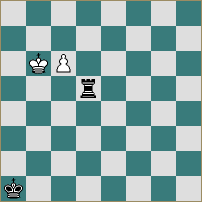Northern Piper: read the bit I quoted about en passant from the laws of chess and you’ll see that the capture is carried out as though the opponent’s pawn had only moved one square forward. The capturing pawn ends up on the square behind the captured pawn.
Yes, but “move forward diagonally” is a little inaccurate. Pawns always move straight forward, but always capture diagonally. The “en Passant” (“on passing”) rule was adopted because, as already mentioned, at one time all pawns at all times could only move forward one square. At the beginning of a game, this became a little silly, with each side alternating pushing a KP or a QP up one square and then another. To eliminate this silliness and speed up the game, the rule was adopted that from its original position, any pawn can move one or two squares at its option, and it need not be at the beginning of the game. So, later on in the game, if the pawn from its initial rank is allowed to push up two squares (instead of one), it can bypass its capture by a pawn on the adjacent file. To eliminate this loophole, the “en passant” rule was adopted. However, it only applies to pawns. A piece is not allowed to capture a pawn using the rule.
Who’s move is it and what is the puzzle? If Black to move, Rd8 draws of course, so it must be White move with Black to draw, but I don’t see how. For example:
- c7 Rd2
- c8(Q) Rb2ch
- Ka5 Ra2ch
- Kb4 Rb2ch
- Kc3 and wins.
I was looking for some underpromotion to prevent stalemate, but I don’t see where White needs any underpromotion to win.
White is on the move.
Alas, barbitu8: Black can draw always if White doesn’t underpromote.
1 c7 Rd6+
…
I see now that Rd6ch draws, but I don’t see where there’s any underpromotion that can enable White to win.
-
c7 Rd6ch
-
Kb7 Rd7draws, of course.
-
Kc5, Rd2 draws
-
Kb5, Rd5 ch
-
Kc4, Rd2 draws again.
-
Kb4, Rd4ch, etc. draws
Yes:
2. Kb7 Rd7 is draw.
2. Kc5? Rd1 ! 3 c8Q Rc1+ etc. white looses
…
2. Kb5 Rd5+
3. Kb4 …
White wins…
Right, but after 2. Kc5, which you give a ? to… Rd1 (or2), 3. Kb6 instead of P/Q) still draws.
Yes: but playing Kc5 implies c8Q, otherwise it would make no sense…
repeat of position is not in the interest of white.
Question: If a pawn advancing two squares on its initial move puts the king into check, does the required move out of check “count” against the opponent who could otherwise capture en passant? I.e., if white’s move 23 sets up the combination of check and potential en-passant pawn capture, does black’s forced move 23 of his king out of check forfeit his opportunity to capture en passant or can he make that capture on move black 24 if he chooses and is otherwise able to?
The en passant must be made immediately. If you do not take advantage of it immediately after the pawn moves up two, you have lost that right.
Kc5 makes sense if White does not want to lose. It is true, tho, that Kb5 wins. And White, now realizing this, can still go into that line.
Correction. Black can now draw.:smack:
If it’s a revealed check (eg, your opponent’s Pawn moves out from in front of a Bishop, aimed at your King) then you’re out of luck. However, if the advancing Pawn itself is what checks your King, there’s no reason you couldn’t capture the Pawn en passant to get out of check.
…
3 Kb4 Rd4+
4 Kb3 Rd3+
5 Kc2! Rd4!
6 c8R!! Ra4 not 6 c8Q?
7 Kb3 … mate is unavoidable
The reason for presenting the Saavedra problem illustrates the OP:
It’s shows that a pawn promotion is possible (in this case a rook - not a queen).
Also, when promoted to a queen instead of a rook, a stalemate situation (the king is not in check, but black cannot move legally without going in check) is created, and the game is draw.
